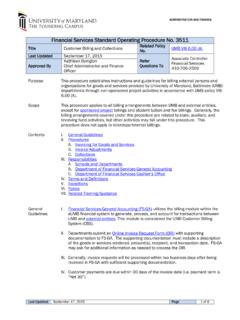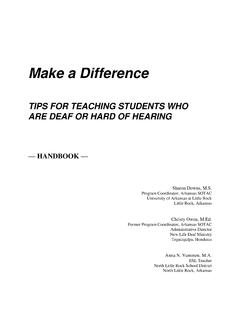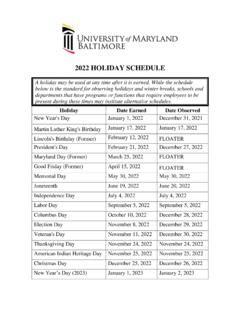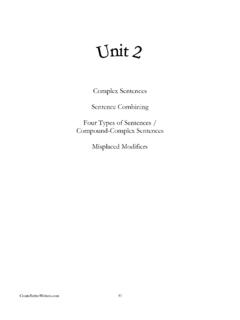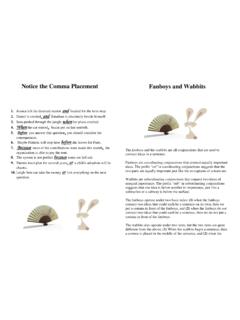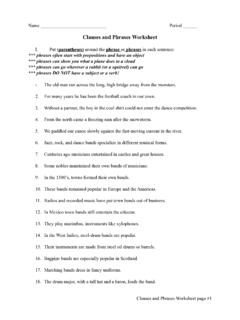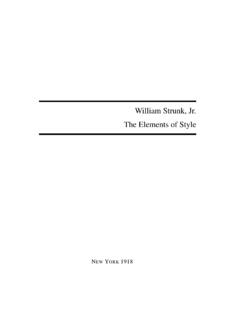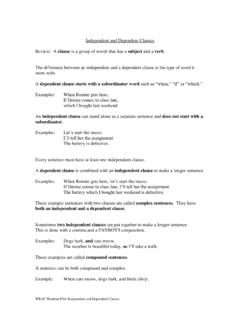Transcription of The Oxford Comma
1 CommasWriting CenterSMC Campus Center621 W. Lombard St. Room are tiny marks that can cause big problems. This handout will help you know when and how to use InformationMost often, commas show readers how the words or phrases contained in a given sentence fit together. They also help to signify a break in the action or, for example, when a reader should pause. In addition, commas distinguish what information is absolutely necessary in a sentence. The Oxford CommaAlso known as a serial Comma , the Oxford Comma is placed immediately before the conjunction usually and, or, or nor in a series of three or more the Oxford Comma : Would you like steak, chicken or pork for dinner?With the Oxford Comma : Would you like steak, chicken, or pork for dinner?While this might seem like a trivial distinction, the Oxford Comma can eliminate : I have invited my parents, Lloyd and : Without the Oxford Comma , it is not clear whether Lloyd and Marilyn are the parents or separate invitees.
2 In other words, it is not clear if there are four invitees or : I have invited my parents, Lloyd, and : The Oxford Comma makes it clear that Lloyd and Marilyn are separate invitees. The 6th edition of the APA Publication Manual requires the Oxford ElementsWhen combining elements, the Comma indicates where one element ends and another : For more information on clauses , please see our handout on this independent ClausesTo join two independent clauses , you must use a Comma and a coordinating conjunction, such as and, but, or, etc. Place the Comma at the end of the first sentence, just before the conjunction. Example: It s terribly cold outside, but I think I ll leave my jacket at Writing CenterSMC Campus Center621 W. Lombard St. Room : For more ways to combine independent clauses , please see our Comma Splices or Run-ons independent and Dependent ClausesSubordinate clauses are dependent clauses which begin with a subordinating conjunction.
3 If the subordinate clause comes before your independent clause, use a Comma at the end of the subordinate . Example: Because I have a big day tomorrow, I have to get plenty of rest Note: Because I have a big day tomorrow is a subordinate , when joining a subordinate clause to the end of an independent clause, do not use a Comma with the subordinating : I have to get plenty of rest because I have a big day tomorrow. Note: Because I have a big day tomorrow is a subordinate ElementsWhen adding an introductory element to your sentence, use commas to help your readers distinguish the introduction from the rest of the sentence. Introductory clauses are subordinate clauses , which means they begin with a subordinating conjunction, such as if, since, when, etc. Clause: If I get up early enough, I will make it to your gym class. Clause: Since she had already eaten, she did not order anything during : For more information about subordinating conjunctions, please see our Conjunctions a sentence begins with an introductory phrase of three or more words, insert a Comma after the : After the party, she went home and fell asleep on her : The clear choice of the people, the candidate humbly accepted her nomination.
4 Note: For more information on phrases, please see our handout on this introductory words also require a Comma . Usually, these words are conjunctive adverbs, like additionally, however, and therefore. Word: However, we must not ignore other possibilities. Word: Therefore, she should act in a ListWhen joining three or more items in a list, use commas to distinguish the words, phrases, or clauses in the series. Be sure to use an Oxford Comma before the : I need to purchase peaches, strawberries, tomatoes, and cucumbers at the farmers AdjectivesCoordinate adjectives are adjectives which describe the same noun. If the word and can be inserted Writing CenterSMC Campus Center621 W. Lombard St. Room two adjectives, or if the order of the adjectives can be reversed, they need to be separated by a Comma . Example: Mrs. Elderberry is a kind, generous : You can tell that kind and generous are coordinate adjectives because you could very easily write that Mrs.
5 Elderberry is a kind and generous woman or a generous and kind woman. You do not need to use commas with cumulative adjectives adjectives that build on each other to modify a noun. In other words, if the adjectives cannot be reordered, do not use : It is an ancient Mayan : You can tell that ancient and Mayan are cumulative adjectives because they build on each other. Mayan modifies legend, and ancient modifies the resulting phrase Mayan legend. Indicating Supplemental InformationWhen used in pairs, commas indicate information that is non-essential or supplemental. Think of the commas as handles you could use them to remove the clause from the sentence without affecting its basic meaning. Adjective (Relative) ClausesAdjective clauses (also known as relative clauses ) act as adjectives, meaning that they provide additional information about nouns.
6 These clauses usually begin with a relative pronoun ( , who/whom, that, or which ).There are two types of adjective clauses : restrictive and nonrestrictive. Restrictive clauses provide essential information about the nouns they modify and cannot be removed from the sentence without altering its meaning. Non-restrictive clauses do not restrict the nouns they modify they add supplemental but nonessential information. Do not use commas to set off restrictive adjective : The guests who were seated ate the : This sentences means that only the guests who were seated ate the pie. The sentence would not mean the same thing if the restrictive clause who were seated were a pair of commas to set off non-restrictive adjective clauses . Non-restrictive: The guests, who were seated, ate the pie. Note: This sentence means that all of the guests ate the pie and that they happened to be seated.
7 The nonrestrictive clause could, in theory, be removed and the sentence still retain its : For more information on adjective clauses , please see our clauses and Pronouns occurs when two nouns or noun phrases which refer to the same person, place, or thing are placed side-by-side. Within this appositive pair, the second noun essentially explains or expands the meaning of the first. Example: This is my friend : My friend and Dale are appositives. Writing CenterSMC Campus Center621 W. Lombard St. Room adjective clauses , apposition can be either restrictive or non-restrictive. Use commas for non-restrictive apposition. Do not use commas to set off restrictive : My brother Jon will meet you : Since Jon restricts the phrase my brother, this sentence suggests that the speaker has multiple brothers and that Jon is the specified one who will be meeting the listener.
8 Non-restrictive: My brother, Jon, will meet you there. Note: Since Jon could in theory be removed, this sentence suggests that the speaker has only one brother. Direct AddressWhen addressing someone directly, set that person s name in : Let s eat, Grandma, before our dinner gets cold. Signaling ContrastTag QuestionsSometimes statements end in brief questions. When this happens, use a Comma to separate the two parts of the : You re not really going to punish me, are you?Final ElementsUse a Comma to highlight the contrast in short elements at the end of a sentence. Example: The bike belongs to my brother, not QuotationsBefore QuotationsUse a Comma to separate what is being said from who said it. If used before a quotation, the Comma should go after the last word before the quote begins. Example: He said, I think it s time for us to go. After QuotationsIf used at the end of a quotation, the Comma should go after the last word of the quote but before the end quotation : I m not sure I m ready to leave, she QuotationsIf a full sentence in a quotation is interrupted, one Comma should be placed after the last word in the first part of the quote, ( inside the quotation marks) and another after the last word of the interrupting : I don t care if you re ready, he hissed, or if you don t want to for whatever reason!
9 Writing CenterSMC Campus Center621 W. Lombard St. Room Quotation Mark UseIn all cases in which quotation marks are used but they are not setting off a direct quotation, the Comma goes inside the quotes. Example: The test groups were termed heavy users, moderate users, and light users. My sister says she surfs, but she actually just boogie : For more information on how to use quotation marks, please see our handout on this UsesDatesUse a Comma to separate the day of the month from the year and after the year. Example: Karen graduated on June 5, 2003, from the University of any part of the date is omitted, leave out the : Karen graduated from the University of Maryland in June NamesUse a Comma to separate the city from the state and after the state in a document. Example: I lived in Baltimore, Maryland, for 20 you use the two-letter capitalized form of a state in a document, you do not need a Comma after the : I lived in Baltimore, MD for 20 & DegreesUse commas to surround degrees or titles used with names.
10 Commas are no longer required around Jr. and Sr. Commas never set off I, II, III, : Silvia Franklin, , knew Sam Jones Jr. and Charles Pointer ErrorsComma SplicesA Comma alone is insufficient to join two independent clauses ( , simple sentences). When you join two sentences with only a Comma , you create a Comma Splice: It s terribly cold outside, I think I ll leave my jacket at : It s terribly cold outside, so I think I ll leave my jacket at : For more information on commas splices, please see our handout on this Commas with Compound SubjectsUnless you have a list of three or more subjects, there s no need to separate with CenterSMC Campus Center621 W. Lombard St. Room Comma : Bill, and Tom went to the : Bill and Tom are the subjects of the sentence. Since there are only two subjects, there is no need to separate them with a Comma .

